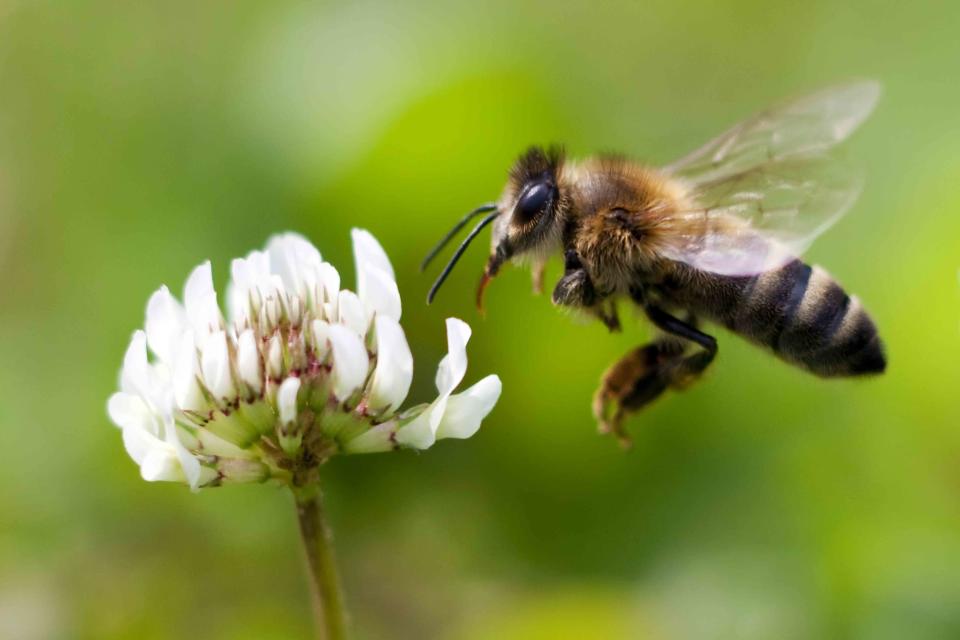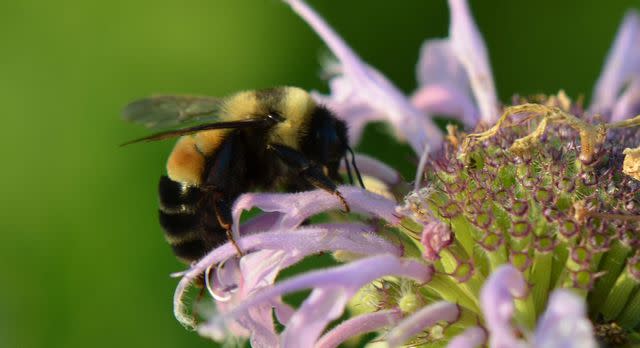Why Some Bees Are Endangered and What We Can Do to Help
We certainly can't live without bees, so let's do our part to keep them buzzing.

The International Union for Conservation of Nature (IUCN) currently lists 156 species of bees as vulnerable, 20 as endangered, and 11 as critically endangered globally. While those numbers are concerning, there are almost 20,000 different species of bees; in the United States alone, there are around 3,500 species. It’s important to keep these big numbers in mind while focusing on the specific species that need protection.
Just like other animal groups, bee species can vary widely. You’re probably most familiar with honey bees and bumblebees; they’re in the group Apidae and have a shared “hivemind.” Surprisingly, they're in the minority; 98% of bee species are naturally solitary, living without a queen or hive. The most common domesticated bee, used for commercial honey and pollination, is the western honeybee (Apis mellifera), which is actually native to Europe, Africa, and western Asia. While its numbers are also declining, the IUCN currently has the species listed as Data Deficient on its Red List of Endangered Species.
In 2016, the first U.S. bee species to earn federal protection under the Endangered Species Act were seven species of Hawaiian yellow-faced bees. Those seven species—Hylaeus anthracinus, Hylaeus longiceps, Hylaeus assimulans, Hylaeus facilis, Hylaeus hilaris, Hylaeus kuakea, and Hylaeus mana—are rare and live only on the Hawaiian Islands. In 2017, the rusty-patched bumblebee (Bombus affinis) was also added to the Endangered Species list. This shrinking species was once common in the upper Midwest and Northeastern United States.
All of these species are dramatically dropping in numbers because of a lethal combination of habitat loss, diseases and parasites, pesticides, and the climate crisis. This doesn’t just affect bees, but people, too—after all, it’s bees who pollinate much of our food in the world.
Threats to Bees
There are multiple ways bees are being threatened in the United States. Most of them are human-made and are a product of poor urban planning and unrestrained industrialization in the modern age. While some steps are being taken to lessen these destructive impacts on bees, some threats do not have complete explanations or solutions.
Habitat Loss and Big Agriculture
With the advent of Big Ag, large commercial farms have destroyed crop diversity and bees’ natural habitats. Land in the Midwest and Northeast that was once prairie or grassland has been converted into monoculture farms that only produce one crop. Commercial farms’ lack of crop diversity means there is less food and variety for bees to munch on. Bees also lose their habitat when inconsiderate urban development transforms green spaces into roads or cities.
Climate Crisis
Hotter temperatures, heavier rains, shorter springs—all of this disturbs bees’ everyday lives. Unpredictable weather patterns affect bees’ nesting behavior and when they might emerge after winter. It also changes when plants begin to flower; if bees and flowers’ timing is off, that will also affect how crops are pollinated. A warming climate also has an impact on bees’ travel range and how far north and south of the equator they can go.
Colony Collapse Disorder
Colony collapse disorder, which was first observed in 2006, causes bees to mysteriously abandon their hive. Affected colonies have experienced mortality rates as high as 90%. A U.S. Department of Agriculture and Environmental Protection Agency report issued in 2013 suggests a complex mix of problems contributing to honeybee colony declines. Contributors include parasites and disease, genetics, poor nutrition and pesticide exposure, as well as unsustainable farming practices that don’t give bees a pesticide-free buffer zone to forage in. Bee colony collapse is a real concern for our economy, as it abuts all aspects of American agriculture.

USFWS Midwest Region / Flickr / public domain
A critically endangered rusty patched bumblebee gathers pollenWhy We Need Bees
If you enjoy meadows full of wildflowers, tomatoes in the summertime, and roses on Valentine’s Day, you can thank a bee for that.
Our Most Important Pollinators
Not all bees are the same. Bumblebees are among the most important pollinators of crops like blueberries, cranberries, and clovers; they are also one of the only insect pollinators of tomatoes. These clever bees are also more effective pollinators than honey bees for some crops because of their ability to buzz pollinate, meaning they will “vibrate” a flower to release more pollen. No amount of technology can replace the hard work bees and other pollinators do: A 2016 U.N. report found that the annual total value of global crops directly affected by pollinators is between $235 billion and $577 billion. Without bees to pollinate our food, we’d have a third less variety of food to choose from—how boring would that be?
What We Can Do
From planting a bee-friendly garden to engaging in community science, there are many ways you can help bees and preserve their habitats.
Organizations
The U.S. Fish and Wildlife Service runs several programs that work to assess, protect, and restore pollinators and their habitats. Get involved or support the North American Pollinator Protection Campaign, a collaboration of scientists, businesses and NGOs dedicated to pollinator conservation and education. This nonprofit is one of the strongest advocates for resident and migratory pollinating populations.
How to Help at Home
Do your research on how to plant a bumblebee-friendly garden. If you don’t have room for a full plot, add a flowering tree or shrub to your yard. Even small areas or containers on patios can provide nectar and pollen for native bees. Always opt for native plants and avoid pesticides when creating green spaces. If you’re a beekeeper or buzzing photographer, participate in community science. We certainly can't live without bees, so let's do our part to keep them buzzing.

